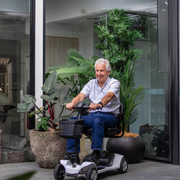- Home
- /
- Buyer's Guides
- /
- Buyer’s Guide to Bathroom Mobility Aids

Buyer’s Guide to Bathroom Mobility Aids
24 February 2025
Discover bathroom mobility aids designed to help people carry out personal care tasks safely, privately and independently.
Many of us take being able to do daily tasks like bathing and toileting for granted. But for people with a disability, these types of activities can present a challenge.
Bathroom mobility aids are designed to make personal care tasks easier, reducing the risk of a fall and helping to maintain independence and privacy. Find out what types of bathroom aids are available and how to make the right choice for your needs in this guide.
Getting help in the bathroom
The type of help someone needs in the bathroom can vary from person to person. It can also change with increased age, illness or just from day-to-day.
Getting help with personal care tasks doesn’t mean losing independence entirely. There are ways to get help while still maintaining privacy and continuing to care for yourself.
Modifying the way you do things or using bathroom mobility aids is often the first step. You may also consider having a carer to help with certain tasks, or even to be there in the event it’s needed.
Bathroom assistance can include helping with:
- Dressing or undressing
- Getting into and/or out of the shower or bath
- Washing in the shower or bath – especially hard to reach places
- Washing, detangling and drying hair
- Dental hygiene such as brushing and flossing
- Physically getting on and off the toilet
- Clean up and managing clothing after using the toilet
When looking at what help may be needed, consider the overall mobility levels of the individual along with any safety considerations and the frequency of tasks. Safety is important, of course, but so is ensuring that the individual feels supported to do things the way they’d like
Bathroom mobility aids to use at home
Mobility aids are designed to assist or improve function when it comes to a range of personal tasks and activities, helping to increase independence and safety.
There is an extensive range of bathroom products to choose from to suit a variety of needs and budgets.
Grab bars and handrails
Bathroom surfaces don’t tend to provide a lot of support, making moving from one area to another difficult. Grab bars and handrails are simple and practical aids that provide extra support when moving from the shower, bath and toilet. They provide a secure surface that can be gripped by the whole hand to prevent a fall.
Grab bars are suited for people who need another point of contact for balance or to assist with transfers or certain bathroom tasks. By positioning the rail on the diagonal or using an L-shaped or angled rail, the person is assisted to balance as they transition from one height to another, as their hand can move to the height required. They can also be used in conjunction with a toilet raiser where the toilet is too low or to maintain balance for cleaning and adjusting clothing.
Suction rails are a solution for people who just need the confidence of touch support when getting in and out of the shower. Being easily movable, they’re ideal for travel or as a temporary solution before grab bars can be installed. They must be positioned on smooth surfaces and should be checked before each use.
Shower chair
A shower chair or stool is ideal for those people who find standing for long periods of time difficult, or who may feel dizzy or off-balance sometimes. They can help to provide privacy while bathing and showering by allowing a carer to assist the individual into the shower, then leaving them to wash themselves.
Shower chairs generally feature a moulded plastic seat, coated aluminium legs and rubber feet. Because of their lightweight design, they can be removed from the shower when needed – such as if other household members or guests need extra space. For smaller areas, consider a shower stool or bench, which tend to take up less room.
Note that positioning the shower chair or stool facing the shower screen door allows more room for stepping in and out of the shower and reduces the risk of tripping when trying to step around the chair leg in a confined space.
Bath chair or bench
A bath chair or bench makes getting into and out of the bath easier – whether with the help of a carer or not. Positioned over the bath, they help provide a sturdy surface to enable showering using a shower hose while seated over the bath.
They are helpful for independent bathing as well as people who may need a carer’s assistance for transfer, but who prefer to bathe themselves. While wrapped in a towel, the individual can be helped to slide into place where they can then remove the towel and wash themselves.
A bath lift is another alternative for people who prefer to sit in the bath. It features an electronic lift function that gently lowers the person in the bath, allowing for independent washing.
Handheld shower
A handheld shower is often used alongside a shower or bath chair to help with washing. They attach to the faucet by a flexible rod and can be used by the individual or their carer. They help to direct water where needed and can be handy for people with limited mobility.
Handheld shower heads often have a lower water pressure, so are ideal for people with sensitive skin.
Over toilet aids
An over toilet aid is a sturdy frame with armrests and a raised toilet seat. It sits over a standard toilet and helps to provide a slightly elevated position for the user. This can reduce some of the difficulty that comes with lowering onto the toilet. The armrests also provide support when standing up again, which can reduce the risk of a fall.
Over toilet aids can be used with or without the assistance of a carer. Because of the higher position, people who have difficulty using a standard toilet without assistance often find toileting easier with an over toilet aid. The height adjustable legs make standing up from the toilet easier. Adjusting the back legs a notch or two higher than the front can enable the feet to be well supported when sitting.
Over toilet aids are height adjustable to make standing from the toilet easier. The back legs can be adjusted a notch or two higher for comfort or to enable the feet to be well supported in sitting, if required
Shower commode
A shower commode can be a handy piece of equipment as it combines the function of a shower chair and an over toilet aid. They feature a sturdy frame to support the user and an open base that makes toileting and cleaning easier. The fitted wheels allow the shower commode to be easily moved into place by the user or their carer. Because it can be used in wet areas, it’s ideal for people who find it difficult to step into the shower or toilet unaided.
It’s important to note smaller bathrooms are generally not suitable for shower commodes as they do require room to manoeuvre. It also requires a walk-in shower to enable the commode to be wheeled into position.
Why bathroom assistance is important
The bathroom is one of most common areas of the home for falls, spills and accidents to occur. For people over 65, around 12% of fall-related hospitalisations happen in the bathroom. And this number doesn’t take into account near misses or minor slips that don’t result in a hospital visit.
As well as getting the right assistance when using the bathroom, there are some other things you can do to increase safety and maintain your independence.
- Keep the bathroom floor as clear as possible. Remove any items such as clothes hamper and bathroom scales. Bathrooms are generally one of the smallest rooms in the house, so these are best kept in a bedroom or wardrobe.
- Clean up patches of water as quickly as possible. Make sure towels and clothes aren’t left on the floor where they could become a tripping hazard. Install extra hooks or rails if needed to keep these things out of the way.
- Use non-slip mats in wet areas like the shower.
- Adjust the hot water temperature to minimise the risk of scalds.
- Place regularly used personal care items – like skincare products and toothbrushes – within arm’s reach. Install shelves or hooks so you don’t have to bend down into cupboards.
- Make sure the bathroom is well lit. Battery operated strip lighting can be installed to brighten areas like the mirror and toilet, if needed.
- Regularly maintain bathroom assistive equipment to make sure they last. Wipe down soap build up, disinfect surfaces that come into contact with skin and check for signs of wear and tear.
What to consider when choosing bathroom aids
When it comes to choosing any bathroom mobility aid, it all comes down to the particular needs of the user – both now and in the future. You’ll want to consider what tasks they find difficult to carry out unaided and what supports they might want to maintain as much independence and privacy as possible.
Your occupational therapist and other medical professionals can also guide you through the options and identify the right assistance.
What are the essential tasks that you might need help with?
You may have noticed or spoken about certain bathroom tasks that have become more difficult. Perhaps you’ve experienced a slip or fall, or a ‘near miss’. Maybe showering isn't being carried out as frequently because of the effort involved. Or there is an expected change in health or mobility that will require more assistance.
How much space is available in the bathroom?
Some mobility aids require a lot of space to use them and may not work in smaller areas. Showers with a lip or edge may not allow a shower commode to be wheeled in (although it is possible to modify an existing shower in some cases – your occupational therapist may be able to provide options).
How is the bathroom currently being used?
Consider how you actually use the bathroom and what personal care tasks you prefer. There’s little point buying a bath lift if you like to shower instead, for example.
Do you tend to get dressed in the bathroom or in the bedroom? Do you use the downstairs toilet more during the day, so that’s the one that should be fitted with an over toilet aid? If you’re installing a grab bar or handrail, which surfaces do you naturally reach for support?
Any mobility aid you buy should be something that supports your current needs, ability and lifestyle.
What is your budget?
Budget is an important consideration when it comes to choosing any mobility aid or assistive equipment. However, consider that cheaper isn’t always the best solution. Durability is important – particularly for mobility aids that will be used daily and exposed to wet areas.
Plenty of mobility aids offer multiple uses – for example an over toilet aid can also be used as a bedside commode. Adjustable elements, like the height of a chair, allow the mobility aid to be adapted to different users or as needs change.
Bathroom Mobility Aids Summary
When it comes to buying any mobility aid or equipment, there are a range of things to consider. Understanding the particular needs of the user as well as how the bathroom space is used will help you find the right products.
Getting expert advice can help you compare options and make an informed decision. The team at Aidacare are experts when it comes to bathroom assistance products and can walk you through the different options available.







